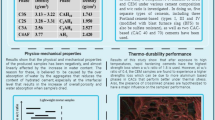Abstract
Cement and asphalt mortar (CA mortar) is the key component in the structure of Shinkansen slab track and serves as the elastic shock-absorber. A new method was put forward to evaluate the setting process of cement and asphalt emulsion (CAE) in CA mortar. It was noted that the setting process was governed by several factors such as cement types, cement/asphalt emulsion ratios (C/AE ratio). Results also indicated that the setting process of CAE was faster, the higher proportion of cement content was; the early age strength and the separation rate of CA mortar could be improved by using cement of high early age strength and rapid hydration rate, or a blended cement with ordinary Portland cement partially replaced by sulfoaluminate cement, or by increasing C/AE ratio. Nevertheless, the replacement ratio of ordinary Portland cement by sulfoaluminate cement should not exceed 15% and C/AE ratio should be not less than 0.8.





Similar content being viewed by others
References
Esveld C (2003) Recent development in slab track. Eur Railway Rev (2):81–85
Takai H (2007) 40 years experiences of the slab track on Japanese high speed lines. In: 1st International Conferences organized by Euskal Trenbide Sarea
Esveld C (1999) Slab track: a competitive solution. Rail Int (6)
Bilow DN, Randich GM (2000) Slab track for the next 100 years. 2000 Annual Conference Proceedings of American Railway Engineering and Maintenance of Way Association
Fu’an G (2006) Slab track structure in passenger line. Railway Standard Design 4:7–10 (in Chinese)
Harada Y, Tottori S, Itai N (1983) Development of cement-asphalt mortar for slab tracks in cold climate. Quart Rep RTRI (Railway Technical Research Institute) 15(1):62–67
Harada Y (1976) Development of ultrarapid-hardening cement-asphalt mortar for grouted-ballast track structure. Quart Rep RTRI (Railway Technical Research Institute) 17(1):6–11
Harada Y (1974) Development and utility of grout for a track structrue with grout filled ballast. Quart Rep RTRI (Railway Technical Research Institute) 15(1):25–27
Weibin L (2003) Construction technology of ballastless track on Qin-Shen passenger railway. Dissertation, Southwest Jiaotong University (in Chinese)
Jingqi Z, Qibing J, Daizheng F (2005) Research on CA mortar in slab track. Railway Constr 9:96–98 (in Chinese)
Shuguang H, Xiangjun X, Qiangjun D (2003) Research on cement paste modified by asphalt emulsion under a dry environment. J Wuhan Univ Technol 25(5):1–3 (in Chinese)
Pouliot N, Marchand J, Pigeon M (2003) Hydration mechanisms, microstructure, and mechanical properties of mortars prepared with mixed binder cement slurry-asphalt emulsion. J Mater Civil Eng 15(1):54–59
Acknowledgements
Research support by the National Natural Science Foundation (NO. 50602033) and the Hubei Natural Science Foundation (CGZ0525) of China is gratefully acknowledged.
Author information
Authors and Affiliations
Corresponding author
Rights and permissions
About this article
Cite this article
Wang, F., Liu, Z., Wang, T. et al. A novel method to evaluate the setting process of cement and asphalt emulsion in CA mortar. Mater Struct 41, 643–647 (2008). https://doi.org/10.1617/s11527-007-9270-9
Received:
Accepted:
Published:
Issue Date:
DOI: https://doi.org/10.1617/s11527-007-9270-9




